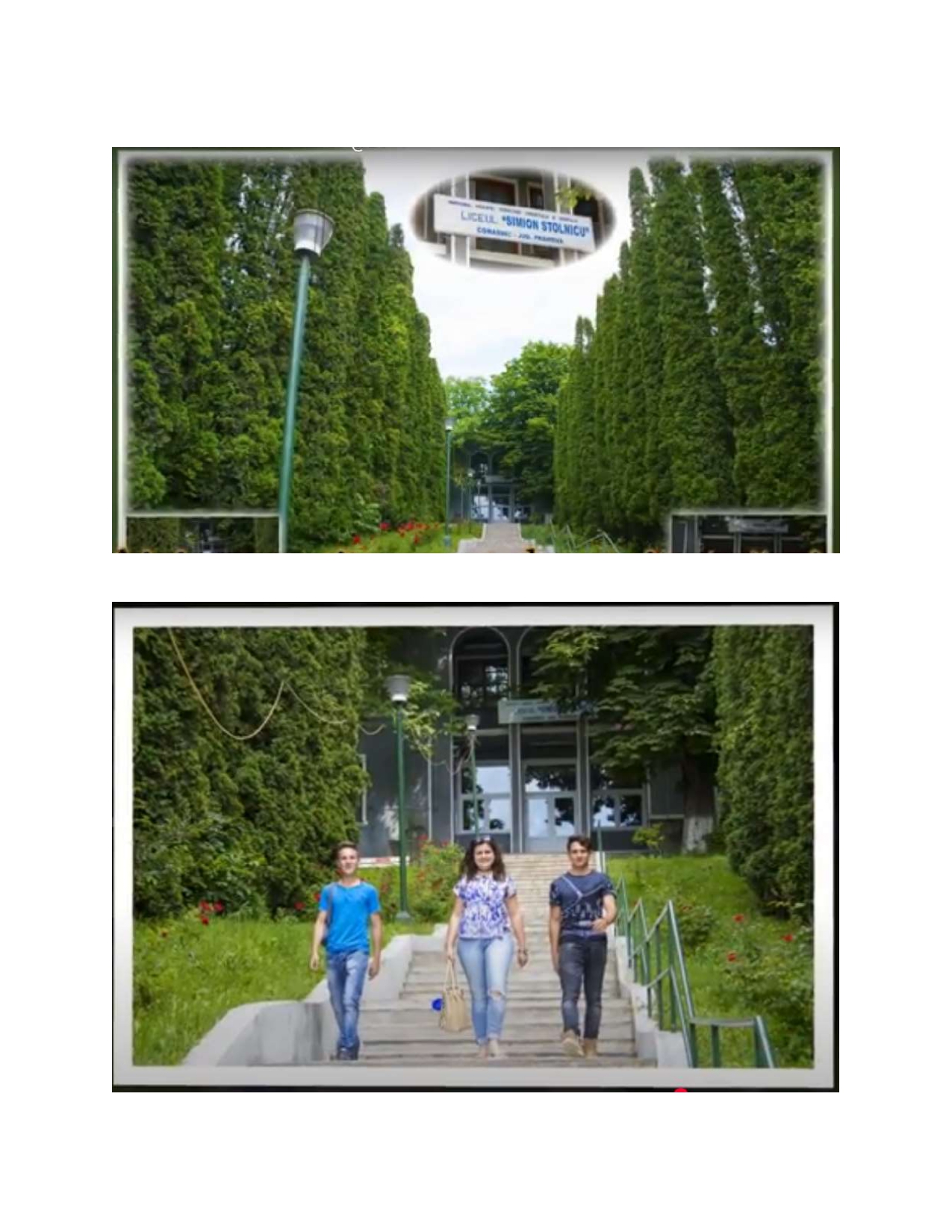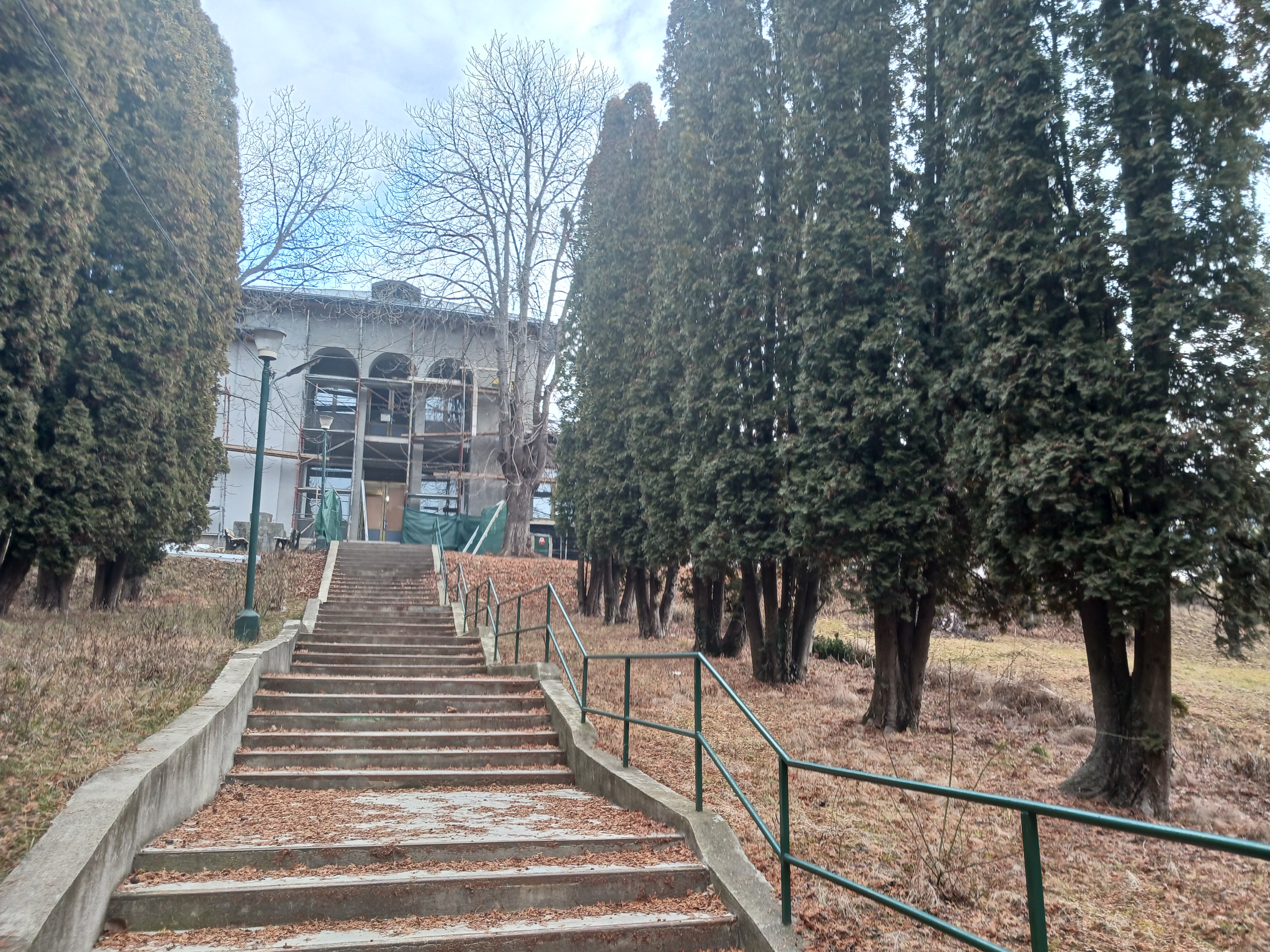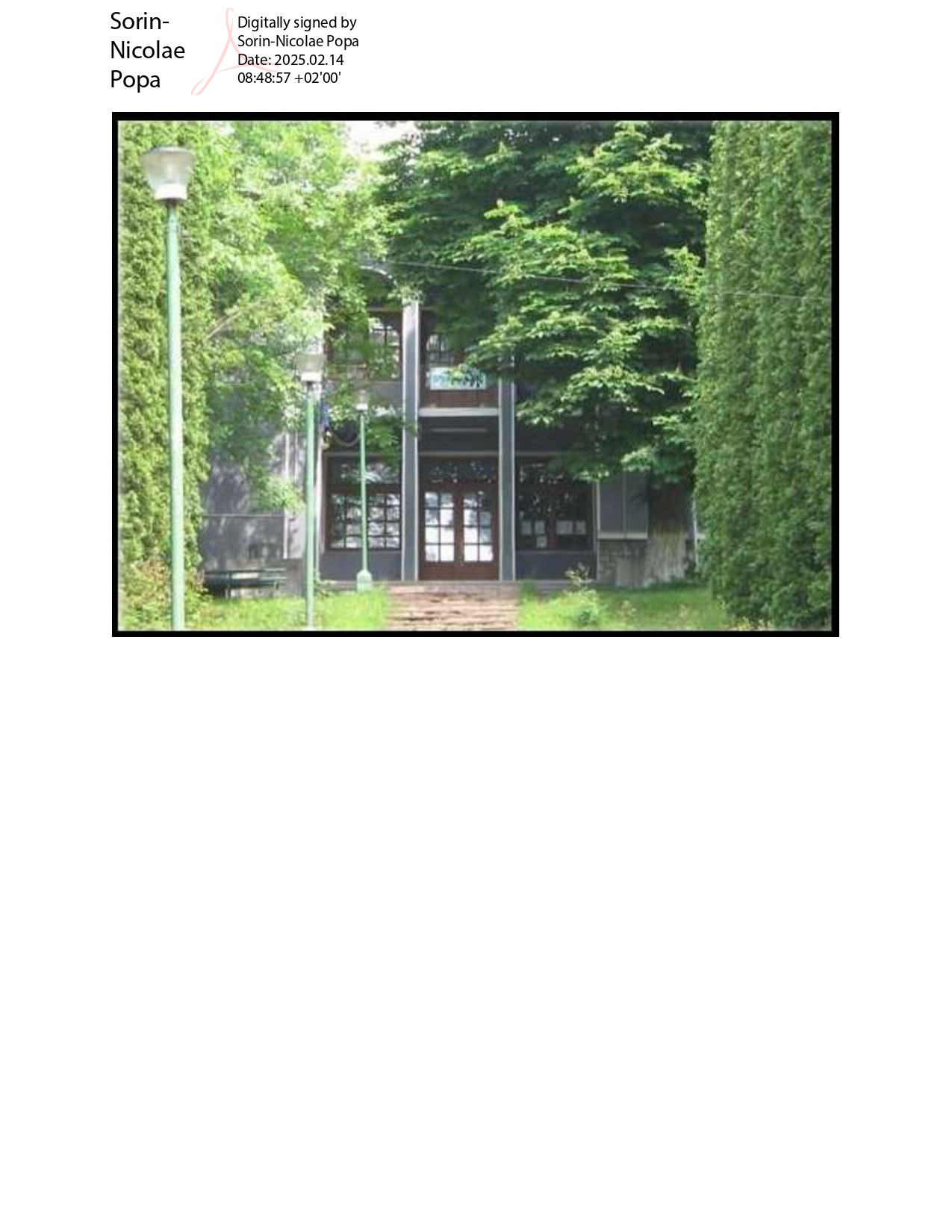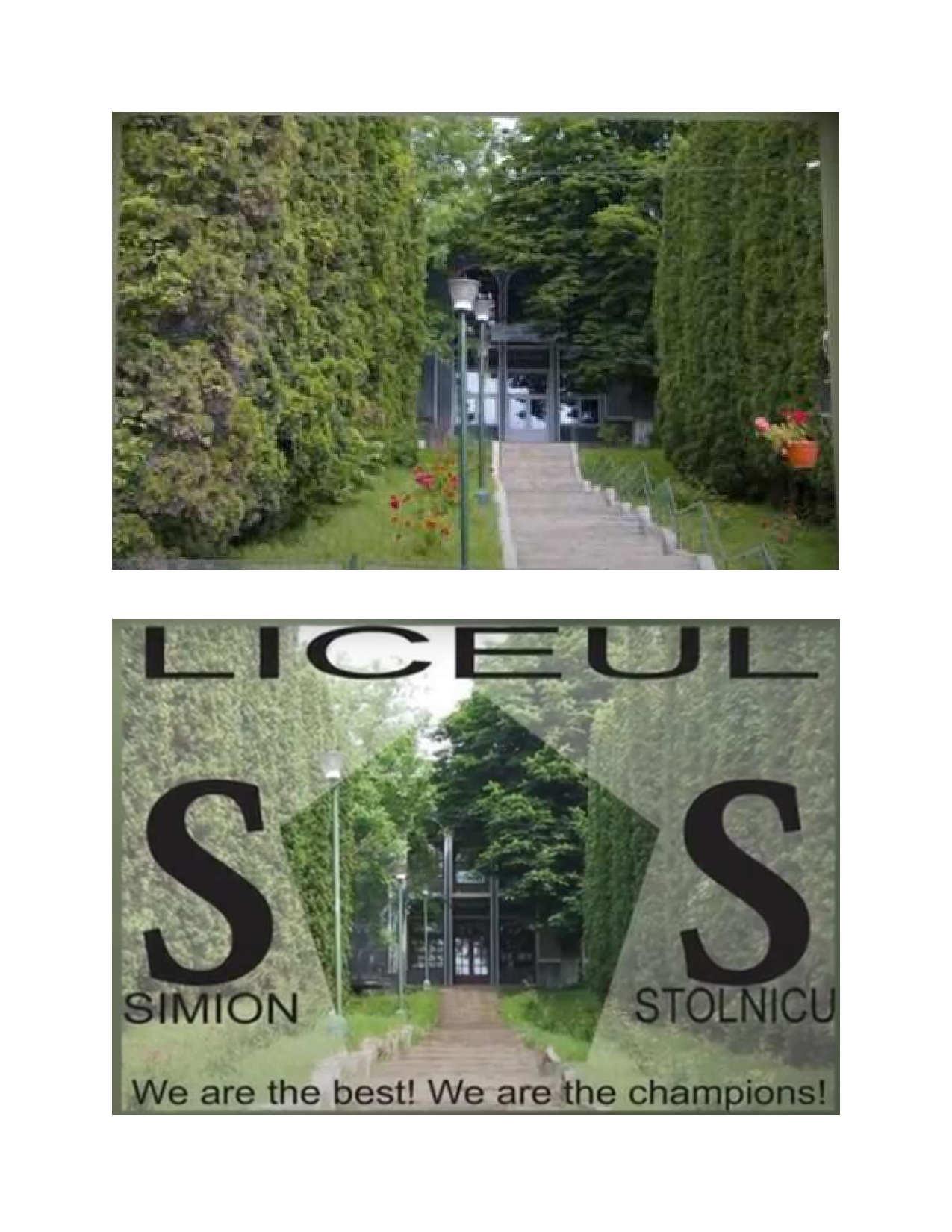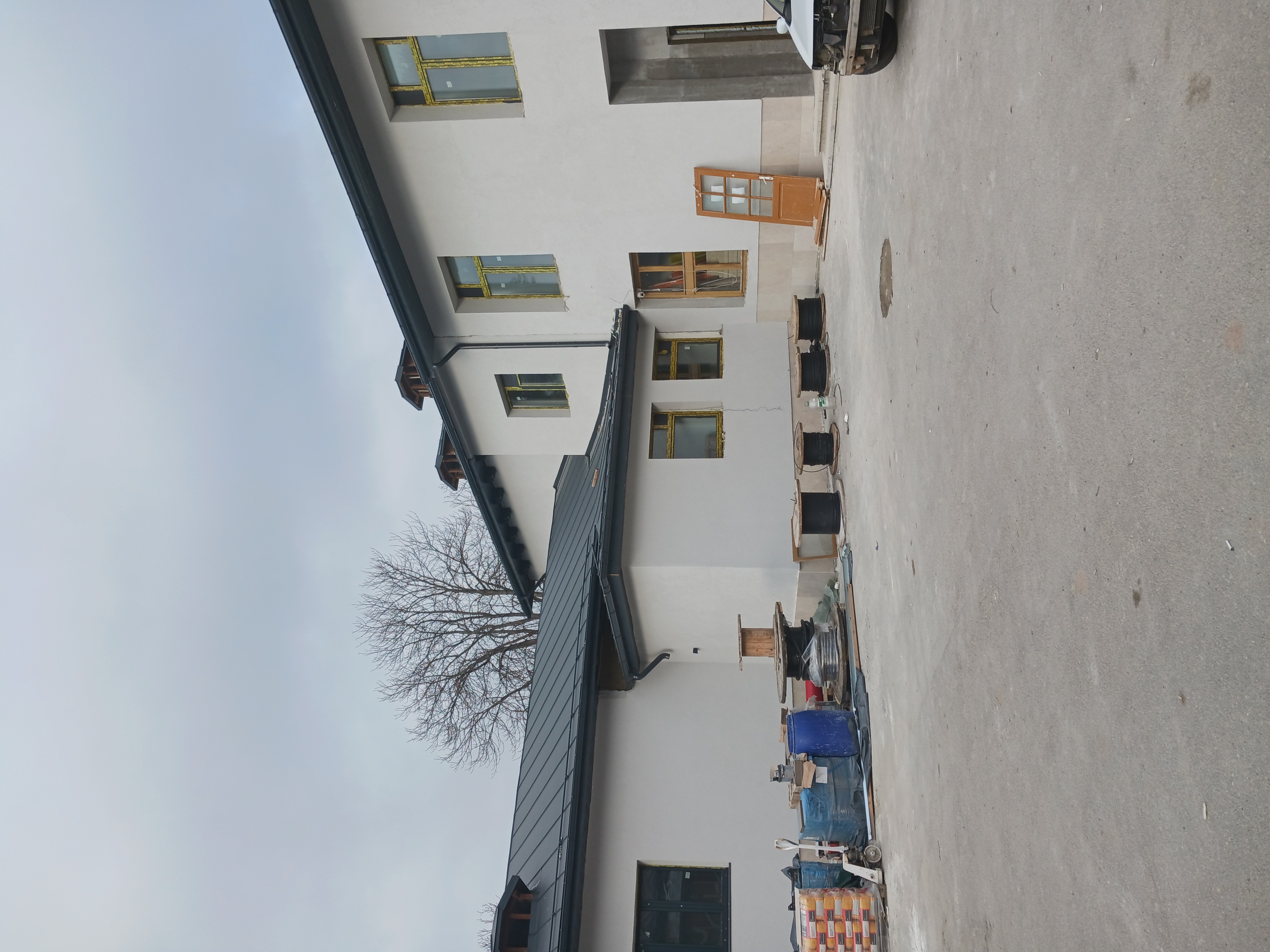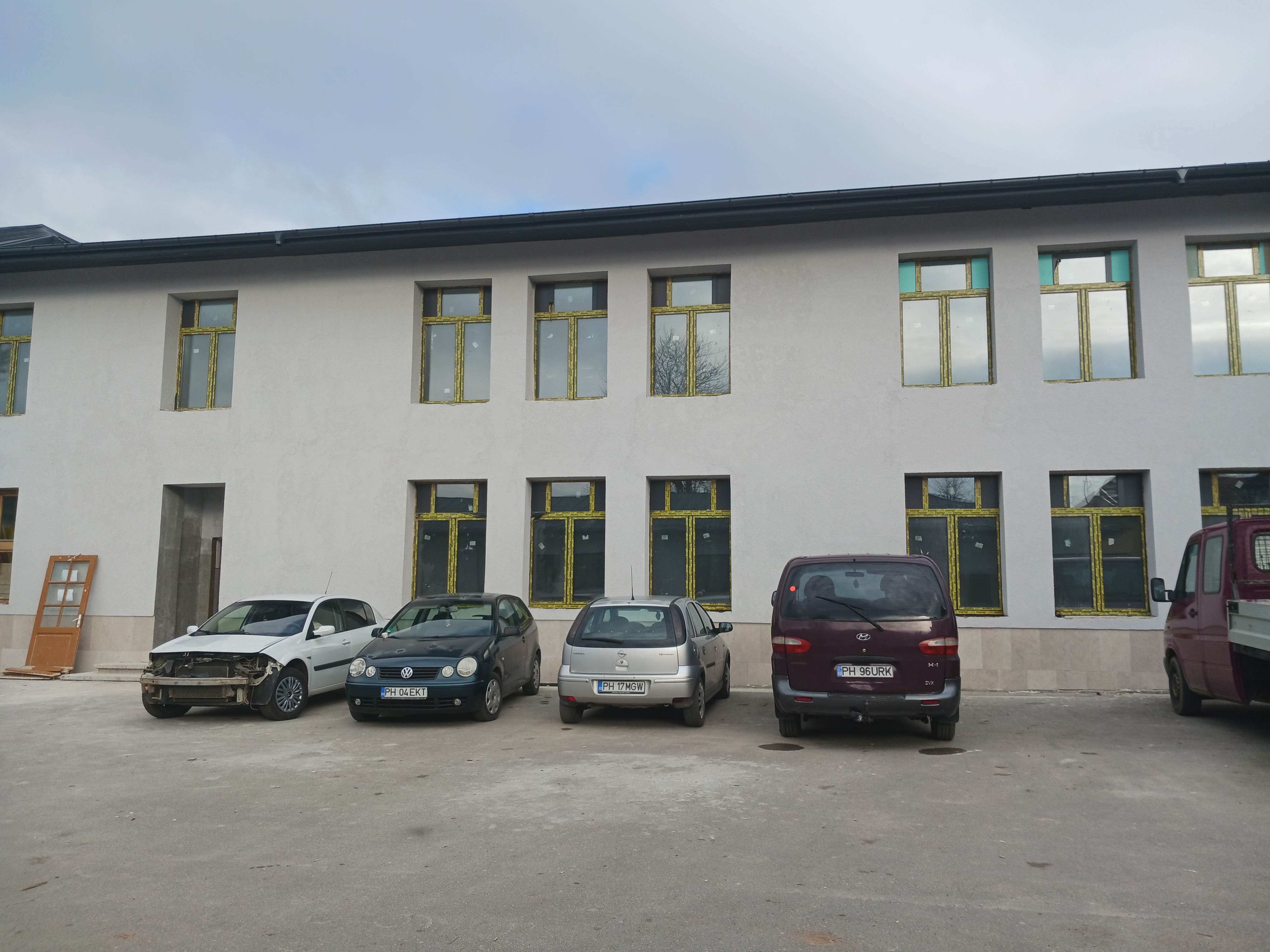Energy Rehabilitation of Simion Stolnicu
Moderate Energy Rehabilitation of Simion Stolnicu High School
Moderate Energy Rehabilitation of Simion Stolnicu High School - Location 1 in the City of Comarnic, Prahova County," approved by Local Council Decision No. 69 of 28.06.2022, is a project sanctioned through the National Recovery and Resilience Plan, Component 10 - Local Fund, Investment: 1.3 - Moderate Rehabilitation of Public Buildings to Improve Services Provided at the Level of Territorial Administrative Units, for which a financing contract was signed under No. 6136 on 17.01.2023
Romania
Prahova, Comarnic, 30 Republicii Street
Early initiative
Yes
Yes
Yes
Yes
ERDF : European Regional Development Fund
National Recovery and Resilience Plan, Component 10 - Local Fund, Investment: 1.3 - Moderate Rehabilitation of Public Buildings to Improve Services Provided at the Level of Territorial Administrative Units, for which a financing contract was signed under No. 6136 on 17.01.2023
No
131336: Oras Comarnic (RO)
General Goal:
Improving the energy efficiency of the high school through rehabilitation and modernization measures, reducing energy consumption and CO₂ emissions, ensuring a sustainable and comfortable environment for students and teachers.
Target Group(s):
• High school students and teachers
• The institution's administrative staff
• The local community
Specific Objectives:
1. Reducing energy consumption by improving the thermal insulation of buildings and modernizing the heating system.
2. Increasing the use of renewable energy sources, such as photovoltaic solar panels and eco-friendly heating systems.
3. Optimizing the lighting system by replacing old bulbs with energy-efficient LED solutions.
4. Ensuring a comfortable indoor climate for students and teachers by modernizing windows, doors, and ventilation systems.
5. Promoting ecological education and awareness regarding energy efficiency among students and the community.
Expected Results:
• Reducing energy costs by at least 30%.
• Lowering the carbon foo
Improving the energy efficiency of the high school through rehabilitation and modernization measures, reducing energy consumption and CO₂ emissions, ensuring a sustainable and comfortable environment for students and teachers.
Target Group(s):
• High school students and teachers
• The institution's administrative staff
• The local community
Specific Objectives:
1. Reducing energy consumption by improving the thermal insulation of buildings and modernizing the heating system.
2. Increasing the use of renewable energy sources, such as photovoltaic solar panels and eco-friendly heating systems.
3. Optimizing the lighting system by replacing old bulbs with energy-efficient LED solutions.
4. Ensuring a comfortable indoor climate for students and teachers by modernizing windows, doors, and ventilation systems.
5. Promoting ecological education and awareness regarding energy efficiency among students and the community.
Expected Results:
• Reducing energy costs by at least 30%.
• Lowering the carbon foo
Reducing energy consumption
Increasing the use of renewable energy sources
Optimizing the lighting system
Ensuring a comfortable indoor climate
Promoting ecological education
I. Essential Values
1. Sustainability
Energy Efficiency: Replacing thermal insulation, high-performance windows, insulating facades, roofs, and basements to reduce heat loss and improve the building’s thermal performance.
• Exterior walls on the ground and first floors were insulated with 15 cm thick basalt wool facade panels.
• Ceilings over the last level (ground and first floors) were thermally insulated with 30 cm thick mineral wool.
• The existing base was waterproofed, and perimeter insulation was redone with 10 cm thick extruded polystyrene.
Renewable Energy: Installing photovoltaic panels on the roof to generate electricity or heat water, reducing dependence on external energy sources and contributing to carbon emissions reduction.
Eco-friendly Materials: Using sustainable building materials such as non-toxic paints, FSC-certified wood, and natural insulation (e.g., sheep wool, cellulose) to enhance energy efficiency and environmental protection.
• Existing exterior carpentry was replaced with high-energy-performance aluminum joinery, with at least five chambers and double glazing with an Argon layer.
2. Inclusion
Accessibility: Ensuring easy access for all users, including people with reduced mobility, through ramps and special signage.
• Secondary accesses in the courtyard, the north, and south wings will be used for persons with disabilities.
• Level differences will be addressed with durable metal profiles resistant to intense traffic, vandalism, and climatic factors.
• Interior level differences between the north and west wings will also be bridged using resistant metal profiles.
Learning Spaces for All: Creating adaptable and flexible learning environments to meet students' diverse needs, including individual and group study areas, collaborative spaces, and relaxation zones.
3. Aesthetics
- The school's architecture is simple, with influences specific to the mountainous region,
- The schoolyard is a green space;
1. Sustainability
Energy Efficiency: Replacing thermal insulation, high-performance windows, insulating facades, roofs, and basements to reduce heat loss and improve the building’s thermal performance.
• Exterior walls on the ground and first floors were insulated with 15 cm thick basalt wool facade panels.
• Ceilings over the last level (ground and first floors) were thermally insulated with 30 cm thick mineral wool.
• The existing base was waterproofed, and perimeter insulation was redone with 10 cm thick extruded polystyrene.
Renewable Energy: Installing photovoltaic panels on the roof to generate electricity or heat water, reducing dependence on external energy sources and contributing to carbon emissions reduction.
Eco-friendly Materials: Using sustainable building materials such as non-toxic paints, FSC-certified wood, and natural insulation (e.g., sheep wool, cellulose) to enhance energy efficiency and environmental protection.
• Existing exterior carpentry was replaced with high-energy-performance aluminum joinery, with at least five chambers and double glazing with an Argon layer.
2. Inclusion
Accessibility: Ensuring easy access for all users, including people with reduced mobility, through ramps and special signage.
• Secondary accesses in the courtyard, the north, and south wings will be used for persons with disabilities.
• Level differences will be addressed with durable metal profiles resistant to intense traffic, vandalism, and climatic factors.
• Interior level differences between the north and west wings will also be bridged using resistant metal profiles.
Learning Spaces for All: Creating adaptable and flexible learning environments to meet students' diverse needs, including individual and group study areas, collaborative spaces, and relaxation zones.
3. Aesthetics
- The school's architecture is simple, with influences specific to the mountainous region,
- The schoolyard is a green space;
Integration of Natural Elements: Utilizing urban and natural landscapes in building design—vertical gardens, green terraces, and landscaped courtyards with plants and trees to enhance the natural environment.
Simion Stolnicu High School is located in a mountain town with a remarkable natural landscape, a rich history, and a slower pace of life, characteristic of the Prahova Valley region.
The high school is named after a Romanian poet and translator, highlighting its connection to literature and human education.
Surrounded by deciduous and coniferous forests, it offers fresh air and a landscape typical of the Sub-Carpathian regions.
Simion Stolnicu High School is situated in a mountain town with a unique natural landscape, an interesting history, and a peaceful pace of life, characteristic of Prahova Valley communities.
- The building is located in an area with an open panorama towards forest-covered hills.
- The school's architecture is simple, with influences specific to the mountainous region, blending into the landscape without disrupting it.
- The schoolyard is a green space where students can spend time outdoors in a quiet and relaxing environment.
- Access to the school is via roads that follow the town's natural terrain, offering a picturesque experience each time someone arrives at the institution.
In conclusion, Simion Stolnicu High School is perfectly integrated into the natural beauty of Comarnic, providing students with a learning environment that is peaceful, clean, and inspiring.
Pleasant Visual Design:
In conclusion, the energy rehabilitation of a high school, in accordance with the principles of the New European Bauhaus, requires a holistic vision in which design and technology merge to create a sustainable, accessible, and beautiful environment that meets both educational and community needs.
Simion Stolnicu High School is located in a mountain town with a remarkable natural landscape, a rich history, and a slower pace of life, characteristic of the Prahova Valley region.
The high school is named after a Romanian poet and translator, highlighting its connection to literature and human education.
Surrounded by deciduous and coniferous forests, it offers fresh air and a landscape typical of the Sub-Carpathian regions.
Simion Stolnicu High School is situated in a mountain town with a unique natural landscape, an interesting history, and a peaceful pace of life, characteristic of Prahova Valley communities.
- The building is located in an area with an open panorama towards forest-covered hills.
- The school's architecture is simple, with influences specific to the mountainous region, blending into the landscape without disrupting it.
- The schoolyard is a green space where students can spend time outdoors in a quiet and relaxing environment.
- Access to the school is via roads that follow the town's natural terrain, offering a picturesque experience each time someone arrives at the institution.
In conclusion, Simion Stolnicu High School is perfectly integrated into the natural beauty of Comarnic, providing students with a learning environment that is peaceful, clean, and inspiring.
Pleasant Visual Design:
In conclusion, the energy rehabilitation of a high school, in accordance with the principles of the New European Bauhaus, requires a holistic vision in which design and technology merge to create a sustainable, accessible, and beautiful environment that meets both educational and community needs.
Inclusion
Accessibility: Ensuring easy access for all users, including people with reduced mobility, through ramps and special signage.
• Secondary accesses in the courtyard, the north, and south wings will be used for persons with disabilities.
• Level differences will be addressed with durable metal profiles resistant to intense traffic, vandalism, and climatic factors.
• Interior level differences between the north and west wings will also be bridged using resistant metal profiles.
Learning Spaces for All: Creating adaptable and flexible learning environments to meet students' diverse needs, including individual and group study areas, collaborative spaces, and relaxation zones.
Project Objective: Combating School Dropout Key benefits of achieving this objective include:
• Motivating students to learn in a hygienic and comfortable environment
• Enhancing the quality of public space
• Creating an attractive urban ambiance and preserving architectural heritage
• Developing the construction sector and production of goods and services
• Revitalizing commercial enterprises involved in investment project design and construction work
• Improving the operations of suppliers of raw materials and construction materials, as well as manufacturers of goods and services.
By implementing energy rehabilitation at Simion Stolnicu High School, the quality of students’ lives will improve, and school dropout tendencies will decrease.
Accessibility: Ensuring easy access for all users, including people with reduced mobility, through ramps and special signage.
• Secondary accesses in the courtyard, the north, and south wings will be used for persons with disabilities.
• Level differences will be addressed with durable metal profiles resistant to intense traffic, vandalism, and climatic factors.
• Interior level differences between the north and west wings will also be bridged using resistant metal profiles.
Learning Spaces for All: Creating adaptable and flexible learning environments to meet students' diverse needs, including individual and group study areas, collaborative spaces, and relaxation zones.
Project Objective: Combating School Dropout Key benefits of achieving this objective include:
• Motivating students to learn in a hygienic and comfortable environment
• Enhancing the quality of public space
• Creating an attractive urban ambiance and preserving architectural heritage
• Developing the construction sector and production of goods and services
• Revitalizing commercial enterprises involved in investment project design and construction work
• Improving the operations of suppliers of raw materials and construction materials, as well as manufacturers of goods and services.
By implementing energy rehabilitation at Simion Stolnicu High School, the quality of students’ lives will improve, and school dropout tendencies will decrease.
Citizen and Civil Society Engagement in the Energy Rehabilitation Initiative
The involvement of citizens and civil society in the energy rehabilitation initiative of the high school has been and will continue to be an essential factor for the project's success and sustainability. This active participation ensures not only community acceptance and support but also a better adaptation of the implemented solutions to the real needs of the building's users.
Ways Citizens and Civil Society Are Engaged
1. Consultation and Participation in Decision-Making
• Organizing public meetings and consultations with students, teachers, and parents to collect suggestions and feedback on the proposed solutions.
• Creating a feedback mechanism through which citizens can submit opinions and proposals at all stages of the project.
2. Education and Awareness
• Conducting awareness campaigns to explain the benefits of energy efficiency and the positive impact of building rehabilitation.
• Integrating the initiative into the school curriculum, allowing students to learn about sustainability and renewable energy through a concrete example.
• Organizing workshops and educational sessions for teachers, students, and parents on the efficient use of the newly installed systems
The involvement of citizens and civil society in the energy rehabilitation initiative of the high school has been and will continue to be an essential factor for the project's success and sustainability. This active participation ensures not only community acceptance and support but also a better adaptation of the implemented solutions to the real needs of the building's users.
Ways Citizens and Civil Society Are Engaged
1. Consultation and Participation in Decision-Making
• Organizing public meetings and consultations with students, teachers, and parents to collect suggestions and feedback on the proposed solutions.
• Creating a feedback mechanism through which citizens can submit opinions and proposals at all stages of the project.
2. Education and Awareness
• Conducting awareness campaigns to explain the benefits of energy efficiency and the positive impact of building rehabilitation.
• Integrating the initiative into the school curriculum, allowing students to learn about sustainability and renewable energy through a concrete example.
• Organizing workshops and educational sessions for teachers, students, and parents on the efficient use of the newly installed systems
In the design and implementation of energy rehabilitation initiatives for public buildings, such as schools, various stakeholders at different governance levels play essential roles.
Local Level
At the local level, the key stakeholders are typically: • Municipal authorities: Local governments usually initiate, fund, and manage the rehabilitation project. They oversee practical implementation and typically collaborate directly with contractors, architects, and engineers.
• School administration: The school board, staff, and students are consulted to understand the specific needs of the building and to ensure the project aligns with educational objectives.
• Local communities: Residents may be involved, especially if the school is a community hub. Public consultations may be organized to gather feedback on the project's impact.
In conclusion, energy rehabilitation projects involve complex coordination among stakeholders at the local level, ensuring that objectives are aligned, resources are maximized, and the initiative's impact is sustainable at various governance levels.
Local Level
At the local level, the key stakeholders are typically: • Municipal authorities: Local governments usually initiate, fund, and manage the rehabilitation project. They oversee practical implementation and typically collaborate directly with contractors, architects, and engineers.
• School administration: The school board, staff, and students are consulted to understand the specific needs of the building and to ensure the project aligns with educational objectives.
• Local communities: Residents may be involved, especially if the school is a community hub. Public consultations may be organized to gather feedback on the project's impact.
In conclusion, energy rehabilitation projects involve complex coordination among stakeholders at the local level, ensuring that objectives are aligned, resources are maximized, and the initiative's impact is sustainable at various governance levels.
In the design and implementation of the energy rehabilitation initiative for the high school, several disciplines and fields of knowledge were involved, contributing to the success of the project. Here are the main fields and how they interacted:
1. Architecture and Civil Engineering
• Role: Architects and civil engineers played an essential role in designing the rehabilitation solutions. They assessed the building’s structure and identified the most efficient renovation solutions, including improving insulation, installing energy-efficient hardware, and implementing sustainable structures. • Collaboration: They worked closely with energy specialists and local authorities to ensure optimal integration of technical solutions and compliance with building and environmental regulations.
2. Energy Efficiency and Green Technologies
• Role: Energy specialists evaluated the building's energy consumption and proposed solutions to reduce it. • Collaboration: Energy engineers interacted with architects and civil engineers to implement these solutions in a way that seamlessly integrates with the building's infrastructure and optimizes energy performance.
3. Education and Learning Psychology
• Role: Education and psychology specialists were involved in integrating the sustainability initiative into the school curriculum. • Collaboration: These professionals worked with the school administration to create educational materials and activities to raise awareness among students and staff about the new energy-efficient solutions implemented in the school.
4. Project Management and Public Administration
• Role: Project management teams and local authorities were involved in coordinating all stages of the project, from planning to implementation. • Collaboration: They collaborated with all involved parties (technical experts, local authorities, and the community) to ensure an efficient workflow and address challenges that arose during implementation.
1. Architecture and Civil Engineering
• Role: Architects and civil engineers played an essential role in designing the rehabilitation solutions. They assessed the building’s structure and identified the most efficient renovation solutions, including improving insulation, installing energy-efficient hardware, and implementing sustainable structures. • Collaboration: They worked closely with energy specialists and local authorities to ensure optimal integration of technical solutions and compliance with building and environmental regulations.
2. Energy Efficiency and Green Technologies
• Role: Energy specialists evaluated the building's energy consumption and proposed solutions to reduce it. • Collaboration: Energy engineers interacted with architects and civil engineers to implement these solutions in a way that seamlessly integrates with the building's infrastructure and optimizes energy performance.
3. Education and Learning Psychology
• Role: Education and psychology specialists were involved in integrating the sustainability initiative into the school curriculum. • Collaboration: These professionals worked with the school administration to create educational materials and activities to raise awareness among students and staff about the new energy-efficient solutions implemented in the school.
4. Project Management and Public Administration
• Role: Project management teams and local authorities were involved in coordinating all stages of the project, from planning to implementation. • Collaboration: They collaborated with all involved parties (technical experts, local authorities, and the community) to ensure an efficient workflow and address challenges that arose during implementation.
The energy rehabilitation initiative of the high school stands out through several innovative aspects compared to current practices in the field. Here are some of the innovative features of this initiative:
Smart Energy Management Technologies
Innovation: The implementation of advanced energy management systems, such as smart thermostats, sensors for monitoring energy consumption, and building automation systems. These technologies allow for dynamic adjustment of energy consumption based on the actual usage of the building.
Compared to mainstream actions: Traditionally, passive solutions such as insulation and efficient fixtures are used.
Added value: Continuous monitoring of consumption and automatic adjustment of energy systems reduce energy losses and ensure more consistent and efficient energy performance.
Integration of Sustainable Education in the Curriculum
Innovation: The integration of the energy efficiency initiative into the educational program, so that students learn directly about sustainability and the use of renewable energy through concrete examples.
Compared to mainstream actions: Most energy rehabilitation projects focus only on technical aspects and do not include education on sustainability in schools.
Added value: This approach contributes not only to improving school infrastructure but also to shaping a generation that is environmentally conscious and responsible.
Smart Energy Management Technologies
Innovation: The implementation of advanced energy management systems, such as smart thermostats, sensors for monitoring energy consumption, and building automation systems. These technologies allow for dynamic adjustment of energy consumption based on the actual usage of the building.
Compared to mainstream actions: Traditionally, passive solutions such as insulation and efficient fixtures are used.
Added value: Continuous monitoring of consumption and automatic adjustment of energy systems reduce energy losses and ensure more consistent and efficient energy performance.
Integration of Sustainable Education in the Curriculum
Innovation: The integration of the energy efficiency initiative into the educational program, so that students learn directly about sustainability and the use of renewable energy through concrete examples.
Compared to mainstream actions: Most energy rehabilitation projects focus only on technical aspects and do not include education on sustainability in schools.
Added value: This approach contributes not only to improving school infrastructure but also to shaping a generation that is environmentally conscious and responsible.
The methodology used in the high school energy rehabilitation initiative was based on an integrated, collaborative, and sustainable approach, focused on optimizing energy consumption and creating an educational environment that supports ecological education. This methodology included several essential steps and aimed to combine technical expertise with active community involvement. Here are the main steps:
Initial Assessment and Needs Analysis
Before starting the project, a detailed evaluation of the building's condition was carried out, including an analysis of energy consumption, infrastructure, and potential for energy efficiency improvements.
Suggestions were collected from all involved parties (students, teachers, parents, local authorities).
Collaboration Between Experts and Stakeholders
Teams of architects, engineers, and energy efficiency experts worked together to develop innovative technical solutions.
Public consultation sessions and meetings with stakeholders were organized.
Implementation of Technical and Educational Solutions
The project included innovative technological solutions, such as energy management systems and the use of renewable energy sources like solar panels.
Sustainability education was also integrated into the school curriculum.
Continuous Monitoring and Adjustment
After implementing the technical solutions, a continuous energy consumption monitoring system was created to evaluate performance and make adjustments where necessary.
Feedback from building users (students, teachers, administrative staff) was gathered to optimize solutions and improve long-term energy efficiency.
Communication and Awareness
Information campaigns were organized for students, teachers, and parents to promote the importance of energy saving and environmental protection.
Overall, the methodology was collaborative, based on active community involvement and the use of best practices in energy efficiency and sustainable education.
Initial Assessment and Needs Analysis
Before starting the project, a detailed evaluation of the building's condition was carried out, including an analysis of energy consumption, infrastructure, and potential for energy efficiency improvements.
Suggestions were collected from all involved parties (students, teachers, parents, local authorities).
Collaboration Between Experts and Stakeholders
Teams of architects, engineers, and energy efficiency experts worked together to develop innovative technical solutions.
Public consultation sessions and meetings with stakeholders were organized.
Implementation of Technical and Educational Solutions
The project included innovative technological solutions, such as energy management systems and the use of renewable energy sources like solar panels.
Sustainability education was also integrated into the school curriculum.
Continuous Monitoring and Adjustment
After implementing the technical solutions, a continuous energy consumption monitoring system was created to evaluate performance and make adjustments where necessary.
Feedback from building users (students, teachers, administrative staff) was gathered to optimize solutions and improve long-term energy efficiency.
Communication and Awareness
Information campaigns were organized for students, teachers, and parents to promote the importance of energy saving and environmental protection.
Overall, the methodology was collaborative, based on active community involvement and the use of best practices in energy efficiency and sustainable education.
The energy rehabilitation initiative of the high school can serve as a model for replication in other locations and for various beneficiary groups, given its integrated and sustainable nature. Here are some elements of the initiative that can be transferred to other contexts:
1. Integrated Collaboration Methodology
o Replicability: The collaborative approach, involving all stakeholders (local authorities, community, professionals from various fields), can be applied in other locations. The process of initial needs assessment, public consultation, and active community involvement are essential aspects that can be adopted in various rehabilitation projects.
o Benefits: Ensures transparency and a shared commitment from all involved parties, which improves the implementation and long-term support of the project.
2. Energy Management Technologies
o Replicability: Smart energy management systems, such as smart thermostats and solar panels, can be implemented in other public or private buildings. These technological solutions can also be adapted to different types of buildings (for example, hospitals, community centers, administrative institutions).
o Benefits: Reduces energy consumption and improves energy performance, contributing to significant financial savings and a reduction in carbon footprint.
In conclusion, the high school energy rehabilitation initiative can be replicated in other locations by adapting the technical, methodological, and educational elements to the local context, and this process could have a significant impact on the sustainable development of other communities and institutions.
1. Integrated Collaboration Methodology
o Replicability: The collaborative approach, involving all stakeholders (local authorities, community, professionals from various fields), can be applied in other locations. The process of initial needs assessment, public consultation, and active community involvement are essential aspects that can be adopted in various rehabilitation projects.
o Benefits: Ensures transparency and a shared commitment from all involved parties, which improves the implementation and long-term support of the project.
2. Energy Management Technologies
o Replicability: Smart energy management systems, such as smart thermostats and solar panels, can be implemented in other public or private buildings. These technological solutions can also be adapted to different types of buildings (for example, hospitals, community centers, administrative institutions).
o Benefits: Reduces energy consumption and improves energy performance, contributing to significant financial savings and a reduction in carbon footprint.
In conclusion, the high school energy rehabilitation initiative can be replicated in other locations by adapting the technical, methodological, and educational elements to the local context, and this process could have a significant impact on the sustainable development of other communities and institutions.
The energy rehabilitation initiative of the high school addresses several global challenges by implementing efficient and sustainable local solutions. Here are some of the global challenges it tackles and the proposed solutions:
Climate change and reducing carbon emissions
Global challenge: Climate change is one of the largest global challenges, and the building sector is responsible for a significant portion of greenhouse gas emissions.
Local solution: Implementing green technologies, such as solar panels and energy management systems, reduces energy consumption from conventional sources and contributes to lowering CO2 emissions. These local solutions help protect the environment and adapt to climate change.
Raising awareness and education for sustainability
Global challenge: Many people are not adequately informed about the importance of energy conservation and environmental protection.
Local solution: Integrating sustainability and energy efficiency education into the school curriculum raises awareness among students, teachers, and the local community. This helps cultivate a responsible attitude toward energy usage and environmental protection.
The need to create sustainable solutions for the future
Global challenge: The growing population and rapid urban development create significant pressure on natural resources and infrastructure.
Local solution: The initiative supports the creation of a sustainable development model that can be replicated in other locations, using energy-efficient solutions and involving the community in the decision-making and implementation process.
Thus, through this local initiative, major global challenges are addressed, demonstrating that local solutions can significantly contribute to achieving global sustainability and environmental protection goals.
Climate change and reducing carbon emissions
Global challenge: Climate change is one of the largest global challenges, and the building sector is responsible for a significant portion of greenhouse gas emissions.
Local solution: Implementing green technologies, such as solar panels and energy management systems, reduces energy consumption from conventional sources and contributes to lowering CO2 emissions. These local solutions help protect the environment and adapt to climate change.
Raising awareness and education for sustainability
Global challenge: Many people are not adequately informed about the importance of energy conservation and environmental protection.
Local solution: Integrating sustainability and energy efficiency education into the school curriculum raises awareness among students, teachers, and the local community. This helps cultivate a responsible attitude toward energy usage and environmental protection.
The need to create sustainable solutions for the future
Global challenge: The growing population and rapid urban development create significant pressure on natural resources and infrastructure.
Local solution: The initiative supports the creation of a sustainable development model that can be replicated in other locations, using energy-efficient solutions and involving the community in the decision-making and implementation process.
Thus, through this local initiative, major global challenges are addressed, demonstrating that local solutions can significantly contribute to achieving global sustainability and environmental protection goals.
The planned activities for the further development and implementation of the high school's energy rehabilitation initiative focus on strengthening and expanding the project's impact, while respecting the values and principles of the New European Bauhaus (NEB). Here are some of the activities and expected steps:
Continuing the implementation of technological and educational solutions
Planned activity: Expanding the use of energy management technologies and renewable energy sources.
NEB values: These solutions align with the principles of sustainability, innovation, and equity, ensuring a long-term impact on energy efficiency and ecological education.
Expected steps: Expanding the infrastructure for renewable energy, organizing additional educational sessions for teachers and students.
Expanding education for sustainability
Planned activity: Developing an extended educational program that includes ongoing training for teachers and workshops for students, with a focus on circular economy and environmental protection.
NEB values: These activities align with the principle of education for all and with the commitment to promoting a greener and more equitable future for the entire community.
Expected steps: Creating training courses for teachers, organizing workshops for students, and integrating sustainability into various fields of study.
Active involvement of the community and beneficiaries
Planned activity: Continuing the consultation and involvement process of all stakeholders, including students, teachers, parents, and local authorities, in the evaluation and adjustment of solutions.
NEB values: Active community involvement reflects the principles of inclusion and participation, which are essential for sustainable and equitable development.
Expected steps: Organizing feedback sessions and periodic evaluations to adjust implementation according to the needs and desires of the community.
Continuing the implementation of technological and educational solutions
Planned activity: Expanding the use of energy management technologies and renewable energy sources.
NEB values: These solutions align with the principles of sustainability, innovation, and equity, ensuring a long-term impact on energy efficiency and ecological education.
Expected steps: Expanding the infrastructure for renewable energy, organizing additional educational sessions for teachers and students.
Expanding education for sustainability
Planned activity: Developing an extended educational program that includes ongoing training for teachers and workshops for students, with a focus on circular economy and environmental protection.
NEB values: These activities align with the principle of education for all and with the commitment to promoting a greener and more equitable future for the entire community.
Expected steps: Creating training courses for teachers, organizing workshops for students, and integrating sustainability into various fields of study.
Active involvement of the community and beneficiaries
Planned activity: Continuing the consultation and involvement process of all stakeholders, including students, teachers, parents, and local authorities, in the evaluation and adjustment of solutions.
NEB values: Active community involvement reflects the principles of inclusion and participation, which are essential for sustainable and equitable development.
Expected steps: Organizing feedback sessions and periodic evaluations to adjust implementation according to the needs and desires of the community.

